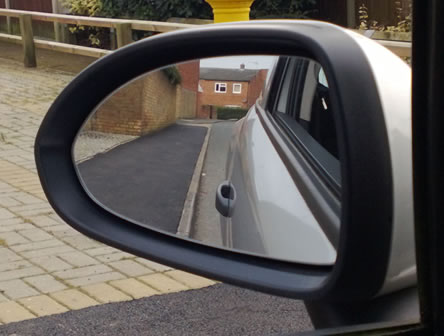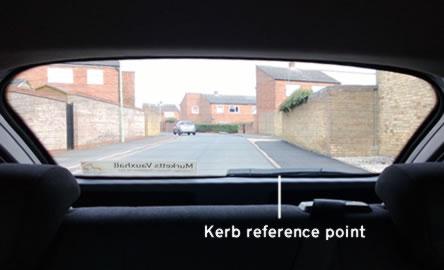when you have passed the practical driving test, there will likely be many occasions that you will need to reverse your car. Straight reverse is essentially reversing in a straight line and then simply stopping.
It not only prepares you for when you have passed the test, but it is the initial manoeuvre required to prepare you for the four main manoeuvres of:
- Turn in the road (not longer assessed on test)
- Reverse round a corner (no longer assessed on test)
- Reverse parallel parking
- Reverse bay parking
- Forward bay parking
- Pulling up on the right
Reversing for the first time can make some a little apprehensive as it is difficult to see and harder to control the car. This straight line reverse tutorial provides the easiest method for performing this manoeuvre.
When practicing this exercise, find a quiet area, a straight kerb and ensure that it is safe, convenient and legal position (SCALP). For the straight reverse, you will need to master three skills all of which will be expected by the examiner during the driving test. They are:
- Accuracy – reversing in a straight line, keeping the car parallel to the kerb and not hit the kerb or drift too far into the road.
- Control – keep the car very slow by use of clutch control. Think of a very slow walking speed.
- Observation – Constant all-round observation.
Let’s begin by pulling up alongside the kerb, not forgetting the Mirror Signal Manoeuvre (MSM) routine of course. Stop a little further from the kerb than normal parking as this will give you a little more room for error. Around 30 cm is acceptable. It’s important that you stop your car parallel to the kerb and not at an angle. If you stop at an angle, you are already setting yourself a challenge to straighten the car when you begin reversing.
Also when you stop alongside the kerb, ensure your steering wheel is straight as it can be difficult to determine whether it is straight after you have stopped. It’s not easy to know when you are parallel with the kerb, so we do this by using reference points.
Straight reverse reference points
In your left mirror, you will want a view similar to this image when you stop. This is around 30 cm from the kerb. Compare this to a similar image from a parked position and you will see little or no road, only the kerb. We can also see that the kerb and car are parallel and not at an angle.

This is your first and very important reference point for getting a good position for reversing. Don’t forget to ensure your steering wheel (front wheels) are also straight. You will continue to use this reference point throughout the straight reverse.
A second reference point to help can be found through the rear windscreen. This image is taken from exactly the same position in the road. As we can see, where the kerb enters the car through the rear windscreen is your reference point.

Make a mental note where the kerb comes in, or you can even place a small sticker or piece of blue tack where the kerb comes into the car to help you remember. It can be kept there for use later when practicing. When you have found the ideal position, select neutral and apply the handbrake.
Removing the seat belt for reversing
Reversing a car requires that you twist round in your seat, looking over your left shoulder to observe out of the rear windscreen where you are going. You may find this a little restrictive whilst your seat belt is on. You are legally entitled to remove your seat belt whilst reversing. If you find it easier to remove the seat belt, do this during the driving test too. If it makes no difference, then simply leave it on. Don’t forget to put it back on at any time you drive forward.
Now we have the perfect position to begin with the straight reverse. Let’s press the clutch down, select reverse gear and place your hand on the handbrake ready to release it.
You may at this time find the clutch bite point if you wish. It’s recommended however to practice all manoeuvres, including the straight reverse without using the bite point as better overall control can be maintained. You should only need to use the bite point if you are moving off uphill.
Look all round to ensure no vehicles are approaching, cyclists or pedestrians that may be affected by your vehicle. If all clear, look the way you are going – out of the rear windscreen, release the handbrake and very slowly release the clutch.
Steering
As you started off in an ideal position, you shouldn’t need to steer very much, if at all. If you do find yourself going off-course, simply remember, steer towards the kerb to move closer to the kerb, steer away from the kerb to get further away from it.
Keeping the car very slow
It is essential that the car is kept slow as you need to apply constant all-round observations and to keep the car under control. This can only be done by clutch control. When releasing the clutch, slowly raise it until the car starts to move. To slow down, dip the clutch slightly, and to speed up, lift the clutch slightly.
All-round observation
As you are reversing, you must constantly look all round for the approach of vehicles, cyclists and pedestrians. You must stop when any one of these gets close, wait until they have passed before proceeding. All though all-round observation is essential for safety reasons, your main observational priority must be in the direction you are traveling – out of the rear windscreen.
At any time you stop, your final observation must be out of the rear windscreen before moving again. Keep reversing for several metres and keep practicing until perfected. When you are proficient with the straight line reverse, you can progress onto the other manoeuvres.

When I am in a country lane I sometimes have to reverse. Most of the time I am ok. One thing is making me anxious. “The mini bus” I’ve even looked up its timetable and still it haunts me. I find when I try to use all my mirrors (too far) especially on a straight narrow bit I keep ending up in the ‘left hand to me hedge!’ Then I have to go forward again and give it another go. One day the bus driver ended up reversing instead of waiting for me! I was not taught how to reverse a long way when learning, only around a corner and I can do that. Please don’t tell me I shouldn’t be on the road as I think apart from my country lane disasters I am a good driver. But I keep meeting this mini bus! It’s giving me really bad anxiety. I just want to know how to reverse using my mirrors without getting all kind of ‘dissoriantated’ just writing about it gives me anxiety, I find some people on the road are so nasty. One more thing, please, ‘don’t anyone tell me to take that bus instead!’
Hi Dizzy,
You’re not alone. Many people find it difficult to reverse and also finds that it makes them anxious. People of ten do it too fast and over-steer. So the thing to do is to slow it right down and adjust the steering by only small amounts. As your confidence increases, you’ll get faster. Looking out the rear window rather than using the mirror might make it easier as you’re literally looking in the direction you’re moving rather than a reflection. Perhaps also use reference points – so as you’re looking out the rear window, look at where the edges of the road come into the window and ensure that they stay in the same place.
So does it matter if I am backing in a straight line on the test with one hand or two hands because I’ve heard one is better than the other and I’m confused and don’t know who to believe
Hi Jennifer,
You can reverse using one hand only. You will need to sporadically look out of the rear windscreen, meaning that you should turn in your seat, this is made easier using one hand. You can even legally remove your seat belt while reversing if this makes it easier.
In reply to jennifer.
Hi Jennifer, I had similar with one of my sons – we lived in rural Wales at the time so the school bus was a constant nemesis !! . We found it helped if we went out either early in the morning or during more quiet times and ” pretended” to meet an oncoming vehicle. We then practiced reversing back to a wider part of the road. Certainly agree with the slow speed approach -and also small inputs to the wheel. We also found looking for passing points as we travelled along so we could gauge how far we needed to reverse if the pesky bus was to appear.